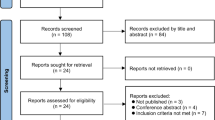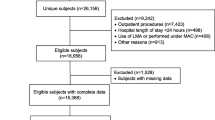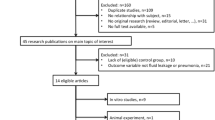Abstract
Purpose
Cuffed endotracheal tubes (ETTs) have increasingly been used in small children. However, the use of cuffed ETTs in small children is still controversial. The goal of this meta-analysis is to assess the current evidence regarding the postextubation morbidity and tracheal tube (TT) exchange rate of cuffed ETTs compared to uncuffed ETTs in children.
Methods
A systematic literature search in PubMed, Web of Science, Embase, and Cochrane Central Register of Controlled Trials up to November 2014 was conducted to identify randomized controlled trials (RCTs) and prospective cohort studies that compared the use of cuffed and uncuffed ETTs in children. The primary outcome was the incidence of postextubation stridor and the second outcomes were the TT exchange rate, need for re-intubation, and duration of tracheal intubation. All pooled data were estimated using random effects meta-analysis.
Results
Two RCTs and two prospective cohort studies including 3782 patients, in which 1979 patients for cuffed tubes and 1803 patients for uncuffed tubes, were included in our analysis. We found that the use of cuffed ETTs did not significantly increase the incidence of postextubation stridor (RR = 0.88; 95 % CI 0.67–1.16, p = 0.36), and the TT exchange rate was lower in patients receiving cuffed tubes intubation (RR, 0.07; 95 % CI 0.05–0.10, p < 0.00001). The need for re-intubation following planned extubations and duration of tracheal intubation did not differ significantly between the cuffed tube group and the uncuffed tube group.
Conclusions
Our study demonstrates that cuffed ETTs reduce the need for TT exchanges and do not increase the risk for postextubation stridor compared with uncuffed ETTs.



Similar content being viewed by others
References
Veyckemans F. New developments in the management of the paediatric airway: cuffed or uncuffed tracheal tubes, laryngeal mask airway, cuffed oropharyngeal airway, tracheostomy and one-lung ventilation devices. Curr Opin Anaesthesiol. 1999;12:315–20.
Flynn PE, Black AE, Mitchell V. The use of cuffed tracheal tubes for paediatric tracheal intubation, a survey of specialist practice in the United Kingdom. Eur J Anaesthesiol. 2008;25:685–8. doi:10.1017/S0265021508003839.
Weiss M, Dullenkopf A, Gysin C, Dillier CM, Gerber AC. Shortcomings of cuffed paediatric tracheal tubes. Br J Anaesth. 2004;92:78–88.
Eschertzhuber S, Salgo B, Schmitz A, Roth W, Frotzler A, Keller CH, Gerber AC, Weiss M. Cuffed endotracheal tubes in children reduce sevoflurane and medical gas consumption and related costs. Acta Anaesthesiol Scand. 2010;54:855–8. doi:10.1111/j.1399-6576.2010.02261.x.
Gopalareddy V, He Z, Soundar S, Bolling L, Shah M, Penfil S, McCloskey JJ, Mehta DI. Assessment of the prevalence of microaspiration by gastric pepsin in the airway of ventilated children. Acta Paediatr. 2008;97:55–60. doi:10.1111/j.1651-2227.2007.00578.x.
Bhardwaj N. Pediatric cuffed endotracheal tubes. J Anaesthesiol Clin Pharmacol. 2013;29:13–8. doi:10.4103/0970-9185.105786.
Weiss M, Gerber AC. Safe use of cuffed tracheal tubes in children. Anasthesiol Intensivmed Notfallmed Schmerzther. 2012;47:232–7. doi:10.1055/s-0032-1310411.
Liberati A, Altman DG, Tetzlaff J, Mulrow C, Gotzsche PC, Ioannidis JP, Clarke M, Devereaux PJ, Kleijnen J, Moher D. The PRISMA statement for reporting systematic reviews and meta-analyses of studies that evaluate health care interventions: explanation and elaboration. PLoS Med. 2009;6:e1000100. doi:10.1371/journal.pmed.1000100.
Moher D, Liberati A, Tetzlaff J, Altman DG. Preferred reporting items for systematic reviews and meta-analyses: the PRISMA statement. Ann Intern Med. 2009;151(264–269):W64.
Phillips B BCSD (2009) Levels of evidence and grades of recommendation. Oxford Centre for Evidence-based Medicine Web site. http://www.cebm.net/index.aspx?o=1025.
Higgins JGS. Cochrane handbook for systematic reviews of interventions. New York: Wiley; 2008.
Wells G SBOC (2014) The Newcastle-Ottawa Scale (NOS) for assessing the quality of nonrandomised studies in meta-analyses. Ottawa Hospital Research Institute Web site. http://www.ohri.ca/programs/clinical_epidemiology/oxford.asp. Accessed Aug 6 2014.
Fan X, Lin T, Xu K, Yin Z, Huang H, Dong W, Huang J. Laparoendoscopic single-site nephrectomy compared with conventional laparoscopic nephrectomy: a systematic review and meta-analysis of comparative studies. Eur Urol. 2012;62:601–12. doi:10.1016/j.eururo.2012.05.055.
Hozo SP, Djulbegovic B, Hozo I. Estimating the mean and variance from the median, range, and the size of a sample. BMC Med Res Methodol. 2005;5:13. doi:10.1186/1471-2288-5-13.
Hedges LV, Pigott TD. The power of statistical tests in meta-analysis. Psychol Methods. 2001;6:203–17.
Higgins JP, Thompson SG. Quantifying heterogeneity in a meta-analysis. Stat Med. 2002;21:1539–58. doi:10.1002/sim.1186.
DerSimonian R, Laird N. Meta-analysis in clinical trials. Control Clin Trials. 1986;7:177–88.
Khine HH, Corddry DH, Kettrick RG, Martin TM, McCloskey JJ, Rose JB, Theroux MC, Zagnoev M. Comparison of cuffed and uncuffed endotracheal tubes in young children during general anesthesia. Anesthesiology. 1997;86(627–631):27A.
Weiss M, Dullenkopf A, Fischer JE, Keller C, Gerber AC. Prospective randomized controlled multi-centre trial of cuffed or uncuffed endotracheal tubes in small children. Br J Anaesth. 2009;103:867–73. doi:10.1093/bja/aep290.
Deakers TW, Reynolds G, Stretton M, Newth CJ. Cuffed endotracheal tubes in pediatric intensive care. J Pediatr. 1994;125:57–62.
Newth CJ, Rachman B, Patel N, Hammer J. The use of cuffed versus uncuffed endotracheal tubes in pediatric intensive care. J Pediatr. 2004;144:333–7. doi:10.1016/j.jpeds.2003.12.018.
Ashtekar CS, Wardhaugh A. Do cuffed endotracheal tubes increase the risk of airway mucosal injury and post-extubation stridor in children? Arch Dis Child. 2005;90:1198–9. doi:10.1136/adc.2005.077651.
Orliaguet GA, Renaud E, Lejay M, Meyer PG, Schmautz E, Telion C, Carli PA. Postal survey of cuffed or uncuffed tracheal tubes used for paediatric tracheal intubation. Paediatr Anaesth. 2001;11:277–81.
Litman RS, Maxwell LG. Cuffed versus uncuffed endotracheal tubes in pediatric anesthesia: the debate should finally end. Anesthesiology. 2013;118:500–1. doi:10.1097/ALN.0b013e318282cc8f.
Silva MJ, Aparicio J, Mota T, Spratley J, Ribeiro A. Ischemic subglottic damage following a short-time intubation. Eur J Emerg Med. 2008;15:351–3. doi:10.1097/MEJ.0b013e3282fc9c5d.
Schramm C, Knop J, Jensen K, Plaschke K. Role of ultrasound compared to age-related formulas for uncuffed endotracheal intubation in a pediatric population. Paediatr Anaesth. 2012;22:781–6. doi:10.1111/j.1460-9592.2012.03889.x.
von Rettberg M, Thil E, Genzwurker H, Gernoth C, Hinkelbein J. Endotracheal tubes in pediatric patients. Published formulas to estimate the optimal size. Anaesthesist. 2011;60:334–42. doi:10.1007/s00101-010-1756-0.
Lonnqvist PA. Cuffed or uncuffed tracheal tubes during anaesthesia in infants and small children: time to put the eternal discussion to rest? Br J Anaesth. 2009;103:783–5. doi:10.1093/bja/aep330.
Acknowledgments
This research work was carried out without funding.
Author information
Authors and Affiliations
Corresponding author
About this article
Cite this article
Shi, F., Xiao, Y., Xiong, W. et al. Cuffed versus uncuffed endotracheal tubes in children: a meta-analysis. J Anesth 30, 3–11 (2016). https://doi.org/10.1007/s00540-015-2062-4
Received:
Accepted:
Published:
Issue Date:
DOI: https://doi.org/10.1007/s00540-015-2062-4




